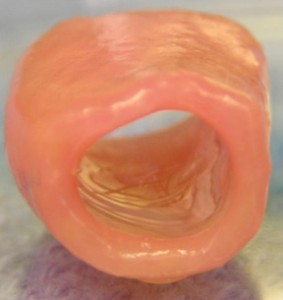Tissue-engineered repairs and replacement parts aren’t just concepts out of science fiction – they promise to provide the ideal solution for thousands of children born each year with congenital anomalies or who suffer devastating injuries. A study released yesterday in The Lancet and covered on NPR reports on the latest tissue engineering advance.
Anthony Atala, a former Children’s Hospital Boston urologist and now director of the Institute for Regenerative Medicine at Wake Forest University School of Medicine, reports on five young boys in Mexico City whose damaged urethras he replaced with laboratory-grown urethras over five years ago. The patients had suffered damage to their urinary tracts from auto accidents, leaving them unable to urinate without a catheter.
In an approach he began at Children’s back in the late 1990s, Atala and his colleagues took a biopsy of bladder tissue from each boy, and expanded the cells in the laboratory until there were approximately 100 million cells of two types: muscle and endothelial. He then seeded the cells on biodegradable, tube-shaped scaffolds. The cells engrafted and created tubes, which were then sewn into the boys’ damaged urethras.The boys’ urinary function was restored to normal, and over the next five years, the new urethras grew with them.
Since engineered tissue is derived from patients’ own cells, there’s no issue of rejection. Nearly 10 years ago, three boys and four girls treated at Children’s were the first people in the world to receive tissue-engineered bladders created in Atala’s lab, and they are reportedly doing well. One of them, Luke Massella, came onstage with Atala during his talk last week at TED2011 — here’s the talk in full:
Also quoted in NPR’s report is Children’s surgeon and researcher Dario Fauza, who’s added a new, proactive twist to tissue engineering that could change the lifelong treatment of children who have defects detected prenatally.
Fauza’s approach, tested in animal models over the last several years, entails removing a sample of amniotic fluid during amniocentesis, isolating fetal stem cells shed into the fluid, and growing them in the laboratory to create a structure or patch that could be grafted in upon birth to repair the defect.
Currently he’s awaiting FDA approval to test a tissue-engineered repair for congenital diaphragmatic hernias (CDHs) in newborns. These are openings in the diaphragm, usually detected on a fetal ultrasound, that allow the abdominal organs (including the stomach, intestines, liver and spleen) to poke through and squeeze the lungs so they’re unable to develop and grow.
The current treatment for CDH is to surgically repair the hole shortly after birth with a Tyvek patch. But in more than 50 percent of cases, the CDH reherniates as the child grows larger and the patch tears away from the diaphragm. Once Fauza’s clinical trial is approved, he will test a tissue-engineered, credit-card-sized alternative. As with the laboratory-grown urethra, this patch will grow along with the baby, so the surgery to place it should be a one-time procedure.
A surgeon affiliated with Children’s Advanced Fetal Care Center, Fauza is also working on tissue-engineered tracheas for newborns with defective tracheas and envisions someday there will be regenerative medicine repairs for facial, limb and chest-wall defects, as well.
Find out more about the concept of fetal tissue engineering in the video below.








